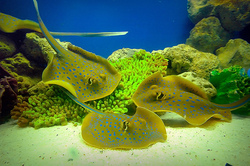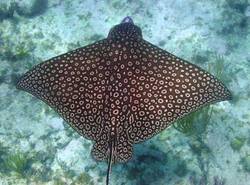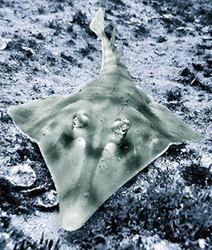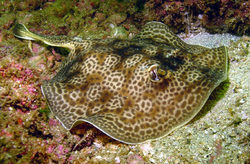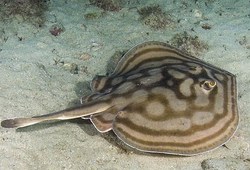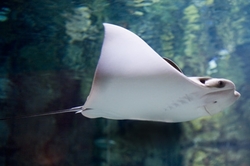Saltwater Rays
Exotic Home
Educational Shows
Penn State University
Apollo the Alligator
Videos
Donations
Alligators as pets
Rescued crocodilians
Rescued crocodilians 2
Sulcata Tortoises
PA Herps
Venomous Snakes
FW Stingrays
SW Rays
Sharks
The Piranha Page
Eels
Toucans
Birds of Prey
My Bio
Christmas Gator
Komodo Dragon
Copperhead Info
Rattlesnake Info
Metabolic Bone Disease
Big Rescue!
Caresheets
Large snakes
Guest Book
Some species of saltwater rays: As mentioned in the FW ray page; there are about 200 species of rays. Stingrays come in two different general "types" - the "benthic" (or bottom) stingrays, and the "pelagic" - (or swimming) stingrays. Benthic rays are often found buried in the sand. They usually have a rounded or "diamond-shaped" body and their stings, when present, are located near the middle or lower third of their "tail." As mostly bottom feeders, these rays generally feed on worms, clams, shrimp, crabs, snails and occasionally fish. Pelagic rays are more active swimmers that have a "bat-like" shape. Pelagic stingrays have stings that are located close to the body, just behind their pelvic fins. Like bottom rays, most pelagic rays also feed largely on bottom-dwelling organisms. The venom apparatus or "sting" of a stingray is a spine or modified dermal denticle (the scales covering sharks and stingrays) with two ventral grooves filled with venom-producing tissue. The venom apparatus is surrounded by a cell-rich covering or sheath that also may produce lesser amounts of venom. The venom itself is a largely protein-based toxin that causes great pain in mammals and may also alter heart rate and respiration. However, since it is proteinaceous, it can be inactivated by exposure to high temperatures. Because of this, immersion of the wound in hot water or application of a heat compress are recommended as an immediate treatment for unfortunate victims of a stingray injury or "envenomation." Although this may reduce the initial pain of a stingray injury, victims should still obtain medical assistance so that the wound can be properly examined and cleaned to avoid secondary infections or other complications.
